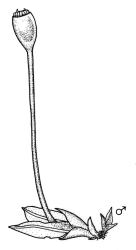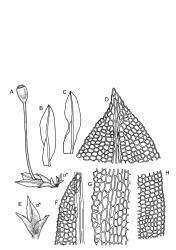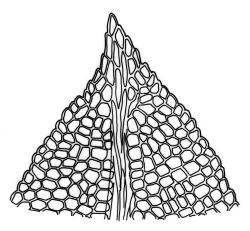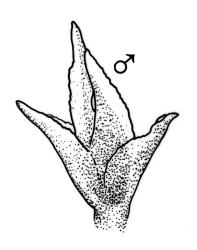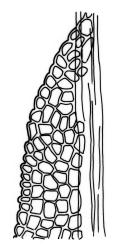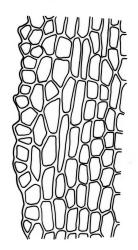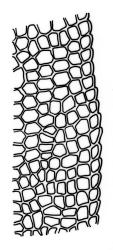Plants minute, 1.5–2.0 mm, dark green to almost black, loosely gregarious, with dark green protonemata often persistent on surrounding soil. Stems simple, with rhizoids at base only. Vegetative leaves not seen, transition directly from juvenile to subperichaetial leaves.
Autoicous? Perichaetia terminal on plants with 2–3 pairs of leaves. Perigonia terminal on bulbiform shoots, at base of fruiting plants or more distant, perhaps connected by rhizoids. Perichaetial leaves plane when moist, little altered when dry, oblong-lanceolate, 1.0–1.8 mm; apex acute; laminae unistratose; vaginant laminae ½–⅔ leaf length, open; dorsal lamina failing above leaf insertion, tapered to its base; margins crenulate to serrulate on dorsal and apical laminae, serrulate to irregularly serrate on vaginant laminae; intramarginal cells of proximal region of vaginant laminae rectangular, forming a weak intramarginal border; cells of apical and dorsal laminae quadrate to hexagonal, smooth, not or slightly bulging, with moderately thick walls, (8–)9–13(–16) × (9–)10–15(–19) µm; costa percurrent, bryoides-type in cross-section. Setae yellow to light-brown, 2–5 mm; capsules erect, symmetric, 0.50–0.75 mm; exothecial cells in 64 columns; operculum conic, ⅔–¾ the length of theca. Peristome scariosus-type; teeth with long, vermicular projections on the adaxial trabeculae, 30–45 µm wide at base. Calyptra smooth to slightly scabrous, mitrate. Spores 9.0–13.5 µm.
Crum & Anderson 1981, fig. 37, A–C; Beever et al. 2002, p. 32, figs 1–3; Smith 2004, fig. 76, 1–3.
This species can be confused with F. tenellus, which also has serrate vaginant lamina margins, but in F. exilis laminal cells are smooth, rather than papillose. In addition, N.Z. plants of F. exilis have a characteristic dark green colour, and persistent dark green protonemata cover the soil between the scattered plants. This coloration assists field discrimination from other minute, soil-dwelling species of Fissidens. Due to its very small size and superficial similarity to F. tenellus, the species is easily overlooked and likely to be much more common than current records indicate.
NI: N Auckland, Wellington (Palmerston North).
Adventive. Widespread in the northern hemisphere.
On bare, shaded soil, in modified habitats. The first published record in N.Z. (Beever 1994) is from Captain Springs Reserve, a small wetland in urban Onehunga, Auckland City. Here the species grew in an area of wetland reclamation, on bare, dry soil, shaded under crack willow (Salix fragilis). The species was also collected in 1994 by T. Suzuki, on the campus of Massey University, Palmerston North (T. Suzuki, pers. comm., Nov. 1989). A mixed gathering of "earth mosses" from urban Auckland, collected "between 1975 and 1985", contains F. exilis (J.K. Bartlett s.n., AK 188589). There are several other localities known in the N Auckland L.D. Associated mosses include Bryum sauteri, F. curvatus, F. taxifolius, F. tenellus, and Pleuridium subulatum, at elevations ranging from 10 m (Ōmana Regional Park, Auckland City) to 80 m (Waipoua Forest Headquarters, N Auckland L.D.).
Since N.Z. specimens conform well to the European lectotype, and the few N.Z. records are all recent and from highly modified habitats, it is considered to be adventive.



